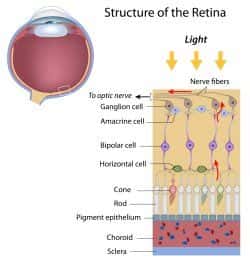The human visual system is a complex network including the eye, ocular nerves, and key brain areas that process visual information. Under most circumstances, we use information from both eyes to create a single visual image. This ability to converge information from both eyes is called binocular vision.
Read more
Retinal disorders are conditions that affect the layer of tissue at the back of the eye, known as the retina. This important part of the eye responds to light and passes on images to the brain. All retinal disorders affect your vision in some way, but some can also lead to blindness.
Macular degeneration. Also known as age-related macular degeneration (AMD), this condition affects the center part of the retina, the macula. This area is needed for the sharp, central vision that is used during everyday activities such as driving, reading or working with tools. This condition is a leading cause of vision loss in people over the age of 60 years old. Treatment can slow the loss of vision, but it will not restore vision that has already been lost.
Diabetic eye disease. The high blood sugar (glucose) levels that occur with diabetes can also affect vision. One type of diabetic eye disease is diabetic retinopathy, which affects the blood vessels in the retina. This can lead to blurry or double vision, blank spots in the vision and pain in one or both eyes. Diabetics may also be at higher risk of developing other eye conditions, such as cataracts and glaucoma.
Retinal detachment. This medical emergency happens when the retina pulls or lifts off of its normal position. It can cause symptoms such as floaters in the field of vision, light flashes and the feeling of a “curtain” in the way of your vision. If not treated right away, a retinal detachment can lead to permanent blindness in that eye.
Retinoblastoma. This cancer of the retina is generally uncommon; although, it is the most common type of eye cancer in children. The cancer starts in the cells of the retina, but can spread to other parts of the body (metastasize).
Macular pucker. Scar tissue on the macula can make the central vision become blurry and distorted. Although the symptoms are similar, macular pucker is not the same as age-related macular degeneration. The symptoms of a macular pucker are usually mild and do not require treatment. Sometimes, the scar tissue can fall off the retina on its own, and the vision will return to normal.
Macular hole. This condition is caused by a small break in the macula, which leads to blurriness and distortion in the central vision. Related to aging, this condition usually happens in people over the age of 60. Some macular holes close up on their own while others require surgery to help improve vision.
Floaters. These are specks, or “cobwebs,” that appear in the field of vision. Unlike scratches on the cornea, which follow your eye movements, floaters can drift even when the eyes are not moving. Most people have some floaters and have no problem with their vision. A sudden increase in the number of floaters, though, can indicate a more serious eye problem such as retinal detachment.
If you notice a change in your vision or simply have not undergone a routine eye ex
-
Binocular VisionCategory: How the Eyes Work
-
Eye PerceptionCategory: How the Eyes Work, Basic Visual Skills
Visual perception refers to a set of skills used to collect and interpret visual information taken in from our environment. The visual information gathered is combined with our other senses, allowing us to derive meaning from what we see. Through the process of merging visual data with our other senses,
Read more -
TearingCategory: Eye Symptoms
Suffering from watery eyes, also known as tearing, or epiphora, is a condition that happens when the eyes make too many tears or produce them constantly. There are many causes of excessive tearing, but only a few are signs of more serious conditions. Causes of Excessive Tearing One of two things often
Read more -
Swollen EyelidsCategory: Eye Symptoms
Swollen eyelids are a fairly common eye condition caused by inflammation or excess fluid in the connective tissues surrounding the eye. Depending on the cause, swollen eyelids can be painful or not painful and affect the upper eyelid, the lower eyelid, or both. Swollen eyes can be caused by many different
Read more -
Sleep in the Eyes (Eye Discharge)Category: Eye Symptoms
Sometimes referred to as "sleep" or eye matter, eye discharge that appears in normal consistency upon waking is a typical part of your body's defense mechanisms, protecting your eyes from bacteria or other irritants. Eye discharge that appears in abnormal consistency, color, or quantities might be a
Read more -
Red EyeCategory: Eye Symptoms
The redness associated with “red eye” is usually caused by dilated or swollen blood vessels. As a result, the surface of the eye looks bloodshot. In contrast to vision problems or pain in the eye, red eye is often less of a concern. However, there are times when red eye may be a sign of a more serious
Read more -
PtosisCategory: Eye Symptoms
Ptosis (TOE-sis) refers to an upper eyelid that droops and can occur in children or adults. The droop may be hardly visible, or it could cover the entire pupil. Depending on the severity of the droop, it could interfere with vision. People with ptosis may try to lift the eyelids or tilt their heads back
Read more -
PhotophobiaCategory: Eye Symptoms
Do you find yourself squinting or closing your eyes in bright light? It could be photophobia or acute light sensitivity. Eyes are designed to respond to light, but certain conditions can create light sensitivity. Exposure to sunlight, fluorescent light, incandescent light and other bright light sources
Read more -
Flashers and FloatersCategory: Eye Symptoms
Many people experience small, dark, cobwebby shapes drifting across their field of vision. These floaters are especially common as people age. Flashes, a similar phenomenon, are quick flickers of light. Both are usually harmless, but, occasionally, can be a sign of serious eye troubles. Causes Vitreous
Read more -
Eye TwitchingCategory: Eye Symptoms
Few eye issues are as simultaneously subtle and annoying as a twitch that comes on suddenly and/or recurs frequently. A twitching eyelid may not appear visible to the people around you at all, but it can make you feel highly self-conscious and drive you to search for the cause and the cure. Unfortunately,
Read more -
Eye PainCategory: Eye Symptoms
Eye pain is not normal and should always be checked by your eye care professional. It is especially urgent if the pain comes with any of the following symptoms: The pain is intense and sudden. Your eye is injured or is being irritated by a foreign object. The pain comes with sensitivity to light or
Read more -
Stargardt DiseaseCategory: Eye Diseases
Loss of eyesight and macular degeneration are typically associated with aging. Stargardt disease, however, an inherited form of macular degeneration, commonly affects children and young adults. Also referred to as Stargardt macular dystrophy (SMD) or flavimaculatus, the term Stargardt disease refers
Read more -
Retinitis PigmentosaCategory: Eye Diseases
The term retinitis pigmentosa (RP) refers to a set of degenerative genetic diseases that gradually kill off the light-sensing cells (rods and cones) of the retina, eventually causing blindness. It is a relatively rare genetic disorder, affecting only 1 in 4,000 people. Retinitis pigmentosa can be difficult
Read more -
Macular DystrophyCategory: Eye Diseases
You may have heard of macular degeneration, an age-related condition in which people suffer permanent vision loss due to damage in a part of the retina called macula. But you may not be so familiar with a similar macular condition that also causes vision loss -- even in young people. This condition,
Read more -
KeratoconusCategory: Eye Diseases
If you find yourself experiencing blurred or distorted vision that seems to get worse year after year, you may suffer from an irregularity of the cornea known as keratoconus. This condition is infamous for causing astigmatism and nearsightedness that can progress rapidly, calling for constant updates
Read more -
Cytomegalovirus (CMV) RetinitisCategory: Eye Diseases
Cytomegalovirus (CMV) retinitis is a serious disease causing compromised vision and ultimately a total loss of vision. CMV retinitis is typically associated with Acquired Immunodeficiency Syndrome (AIDS). In the early days of the AIDS epidemic, nearly one-quarter of all individuals diagnosed with late-stage
Read more

